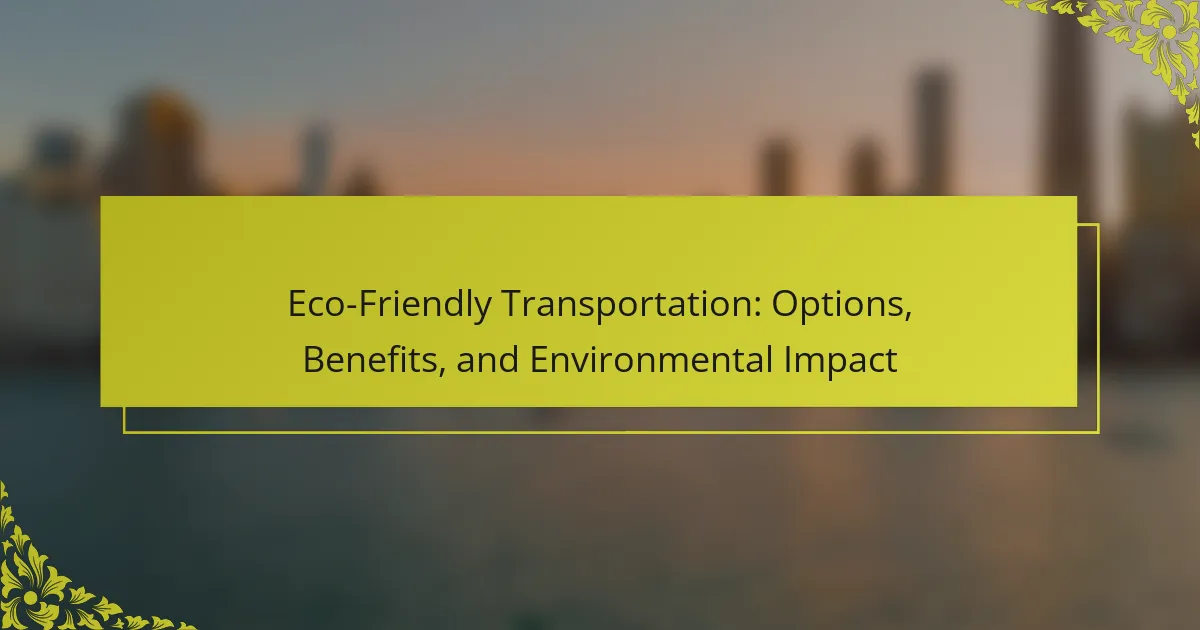Eco-friendly transportation options significantly reduce carbon emissions and enhance urban livability. Explore electric vehicles, bicycles, public transit, and walking as sustainable choices. Understand the benefits, including lower fuel costs and improved public health. Examine the environmental impact of traditional methods and the role of technology in shaping a greener future.
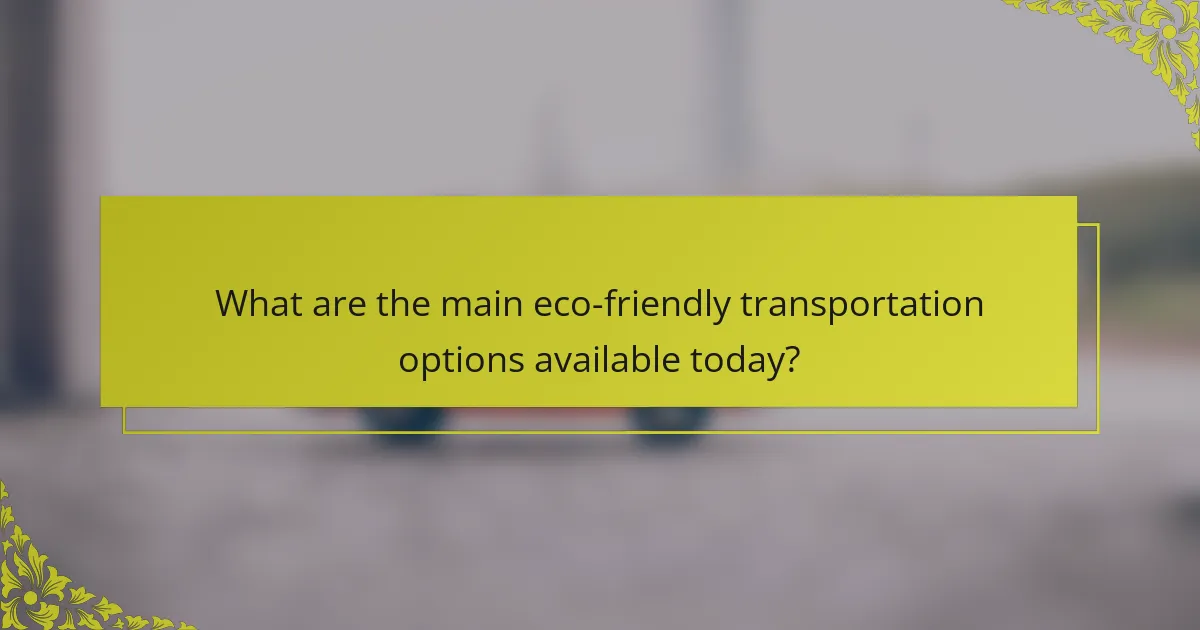
What are the main eco-friendly transportation options available today?
Eco-friendly transportation options today include electric vehicles, bicycles, public transit, and walking. These modes significantly reduce carbon emissions and promote sustainable practices.
Electric vehicles (EVs) utilize battery power, offering a cleaner alternative to traditional gasoline cars. Bicycles provide a zero-emission means of transport, improving health and reducing traffic congestion. Public transit systems, such as buses and trains, efficiently move large numbers of people, lowering individual carbon footprints. Walking remains the simplest and most eco-friendly option, requiring no energy beyond human effort.
Adopting these transportation methods contributes positively to environmental sustainability and urban livability.
How do electric vehicles contribute to sustainable transport?
Electric vehicles significantly contribute to sustainable transport by reducing greenhouse gas emissions and promoting energy efficiency. They operate on electricity, which can be sourced from renewable energy, unlike traditional vehicles that rely on fossil fuels. This shift decreases air pollution and mitigates climate change effects. Furthermore, electric vehicles have lower operating costs due to fewer moving parts and reduced maintenance needs, making them economically viable over time. As a result, their adoption supports a transition towards cleaner urban mobility and sustainable transportation systems.
What role do public transit systems play in reducing carbon footprints?
Public transit systems significantly reduce carbon footprints by providing efficient transportation alternatives to individual car use. They decrease traffic congestion and lower greenhouse gas emissions. For instance, buses emit 45% less carbon dioxide per passenger mile than single-occupancy vehicles. Furthermore, cities with robust public transit options often see a reduction in urban air pollution levels. By promoting shared rides, public transit systems contribute to sustainable urban development and help mitigate climate change impacts.
Which alternative fuels are gaining popularity in transportation?
Electric vehicles, hydrogen fuel cells, and biofuels are gaining popularity in transportation. These alternative fuels reduce greenhouse gas emissions and reliance on fossil fuels.
Electric vehicles (EVs) have surged due to advancements in battery technology, offering a range of 250-370 miles on a single charge. Hydrogen fuel cells provide quick refueling times and emit only water vapor. Biofuels, derived from organic materials, offer a renewable option that can blend with traditional fuels.
As a result, these options enhance sustainability in transportation while promoting energy independence. The shift towards these fuels is crucial for meeting climate goals and improving air quality.
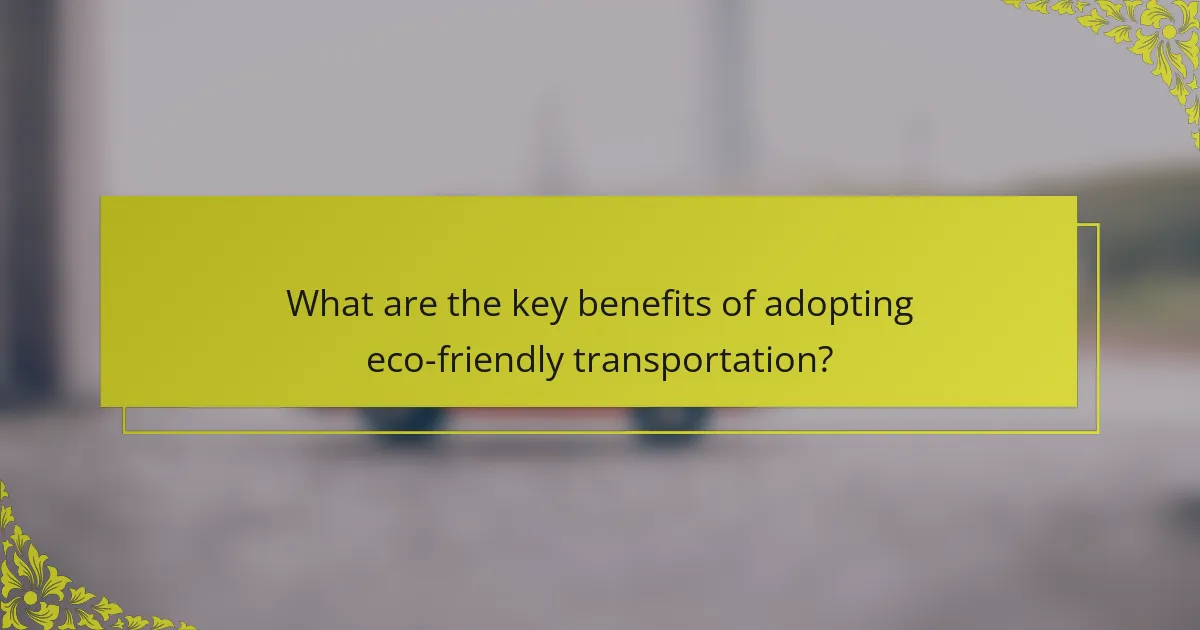
What are the key benefits of adopting eco-friendly transportation?
Adopting eco-friendly transportation offers significant benefits, including reduced carbon emissions, lower fuel costs, and improved public health. These options, such as electric vehicles and public transit, contribute to cleaner air and less traffic congestion. As a result, communities experience enhanced quality of life and sustainability. Eco-friendly transportation also promotes energy independence and supports the transition to renewable energy sources.
How does eco-friendly transportation improve air quality?
Eco-friendly transportation significantly improves air quality by reducing harmful emissions. Electric vehicles, bicycles, and public transit options emit less pollution compared to traditional vehicles. For example, electric cars produce zero tailpipe emissions, directly decreasing the concentration of pollutants like nitrogen oxides and particulate matter in urban areas. As a result, communities experience fewer respiratory issues and improved overall health. Transitioning to greener transport options can lead to a measurable reduction in air pollution levels, contributing to a healthier environment.
What economic advantages come from using sustainable transport methods?
Sustainable transport methods offer significant economic advantages. They reduce fuel costs, lower maintenance expenses, and create job opportunities in green industries. Furthermore, these methods can lead to decreased healthcare costs through improved air quality and reduced traffic accidents. Investing in sustainable transport can enhance local economies by attracting eco-conscious businesses and tourists.
How can eco-friendly transportation enhance community well-being?
Eco-friendly transportation enhances community well-being by reducing pollution and promoting healthier lifestyles. It encourages walking, cycling, and the use of public transit, which fosters social interactions. Communities with accessible eco-friendly options often see improved mental health and lower stress levels. Additionally, these transportation methods contribute to a cleaner environment, which can lead to increased property values and economic growth.
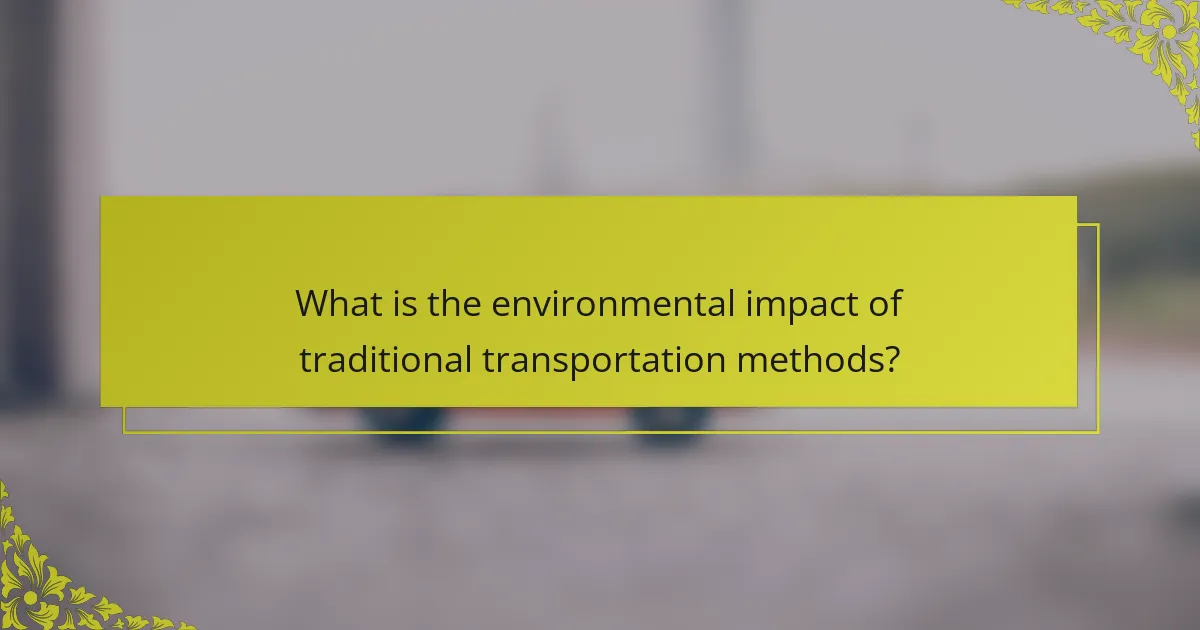
What is the environmental impact of traditional transportation methods?
Traditional transportation methods significantly contribute to environmental degradation through greenhouse gas emissions, air pollution, and habitat destruction. These impacts stem from reliance on fossil fuels, which release carbon dioxide and other pollutants during combustion. For instance, road vehicles are responsible for approximately 29% of total greenhouse gas emissions in the United States. Additionally, traditional transportation can lead to increased noise pollution and urban sprawl, which disrupt local ecosystems. Transitioning to eco-friendly transportation options can mitigate these negative effects and promote sustainability.
How does vehicle emissions affect climate change?
Vehicle emissions significantly contribute to climate change by releasing greenhouse gases, primarily carbon dioxide. These gases trap heat in the atmosphere, leading to global warming and adverse environmental impacts. Reducing vehicle emissions through eco-friendly transportation options can mitigate these effects. For example, electric vehicles produce zero tailpipe emissions, while public transport reduces the number of individual cars on the road. Transitioning to sustainable transportation methods is crucial for lowering overall emissions and combating climate change effectively.
What are the long-term ecological consequences of fossil fuel dependency?
Fossil fuel dependency leads to severe long-term ecological consequences, including climate change, habitat destruction, and increased pollution. The reliance on fossil fuels contributes to greenhouse gas emissions, which drive global warming. As a result, ecosystems face disruptions, leading to loss of biodiversity. Additionally, air and water quality deteriorate, impacting both human health and wildlife. Transitioning to eco-friendly transportation options can mitigate these effects and promote a sustainable future.
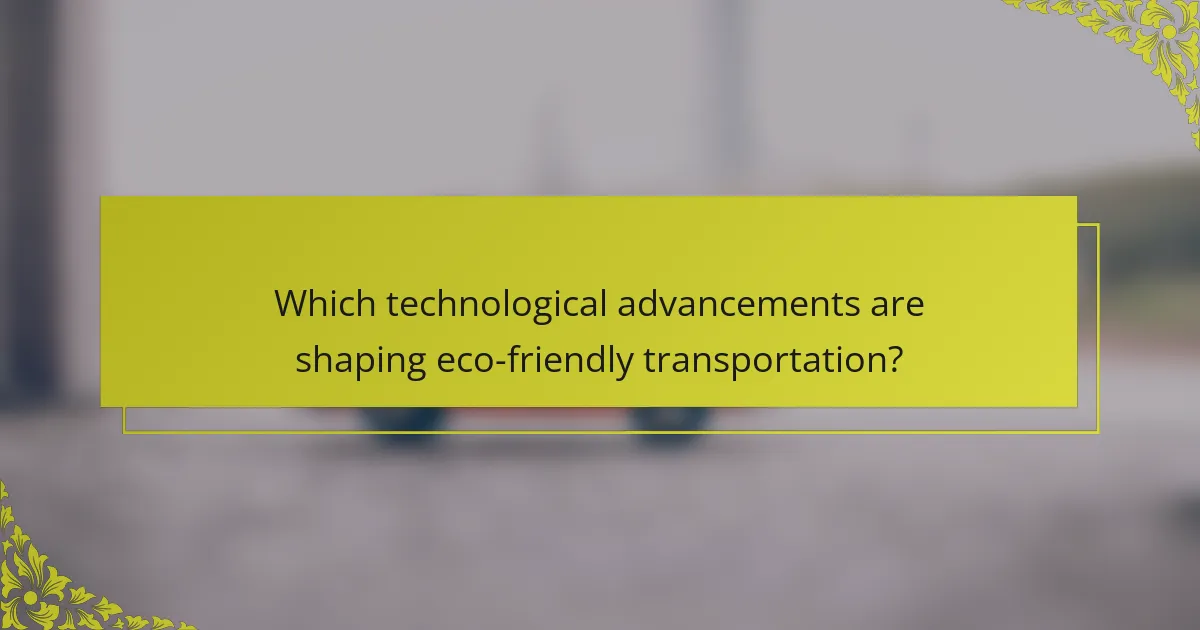
Which technological advancements are shaping eco-friendly transportation?
Technological advancements such as electric vehicles, hydrogen fuel cells, and autonomous driving systems are shaping eco-friendly transportation. These innovations reduce emissions, enhance energy efficiency, and improve urban mobility. Electric vehicles, for example, utilize advanced battery technology, offering ranges exceeding 300 miles. Hydrogen fuel cells provide a clean alternative, emitting only water vapor. Autonomous systems optimize traffic flow, further minimizing environmental impact. As a result, these technologies collectively contribute to a sustainable transportation future, aligning with global environmental goals.
How are smart transportation systems optimizing energy use?
Smart transportation systems optimize energy use by enhancing efficiency, reducing emissions, and utilizing real-time data. These systems employ technologies such as smart traffic signals and connected vehicles to minimize congestion, which leads to lower fuel consumption. For instance, adaptive traffic signals adjust their timing based on traffic flow, decreasing idle times and energy waste. Additionally, electric and hybrid vehicles integrated within smart systems contribute to reduced reliance on fossil fuels, further supporting eco-friendly transportation goals. Overall, smart transportation systems play a crucial role in promoting sustainable energy practices in urban environments.
What innovations are being made in battery technology for electric vehicles?
Innovations in battery technology for electric vehicles focus on enhancing energy density, reducing charging time, and improving lifespan. Solid-state batteries, for example, offer higher energy density and safety compared to traditional lithium-ion batteries. Advanced materials like silicon anodes are being developed to increase capacity, potentially reaching 400 Wh/kg. Furthermore, fast-charging technologies are evolving, enabling vehicles to charge in under 30 minutes. These advancements not only boost performance but also contribute to the overall sustainability of eco-friendly transportation.
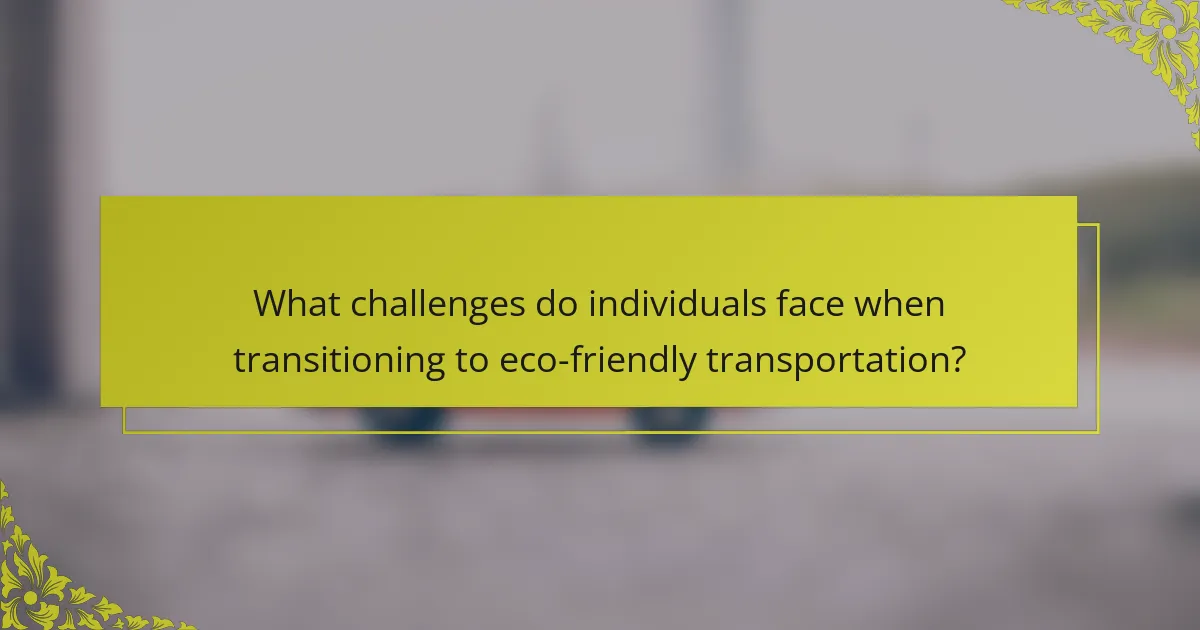
What challenges do individuals face when transitioning to eco-friendly transportation?
Individuals face several challenges when transitioning to eco-friendly transportation. High initial costs for electric vehicles and charging infrastructure can deter adoption. Limited availability of charging stations in certain areas creates accessibility issues. Additionally, individuals may encounter range anxiety, worrying about battery life during long trips. Maintenance and repair options for eco-friendly vehicles can also be less accessible compared to traditional options. Finally, a lack of knowledge about available incentives and benefits may hinder the transition to greener choices.
How can infrastructure improvements support sustainable transport adoption?
Infrastructure improvements can significantly enhance sustainable transport adoption by providing essential support and accessibility. Upgraded public transit systems, such as electric buses and bike lanes, encourage users to shift from personal vehicles. Enhanced infrastructure reduces travel times, increases safety, and promotes eco-friendly options. For instance, cities investing in pedestrian-friendly designs report higher rates of walking and cycling. Improved access to charging stations for electric vehicles further supports this shift, making sustainable transport more convenient and appealing.
What are the common misconceptions about eco-friendly transportation options?
Many misconceptions surround eco-friendly transportation, including beliefs about cost, efficiency, and availability. One common myth is that electric vehicles are too expensive, but costs have significantly decreased, making them more accessible. Another misconception is that public transportation is inconvenient; however, many urban areas offer reliable and efficient transit options. People often think that cycling is unsafe, but improved infrastructure has made it safer for riders. Lastly, some believe that eco-friendly options are less effective than traditional vehicles, yet studies show they can reduce carbon emissions significantly.

How do cultural attitudes influence the adoption of eco-friendly transportation?
Cultural attitudes significantly shape the adoption of eco-friendly transportation. Societies valuing sustainability often embrace electric vehicles and public transport, while those prioritizing convenience may resist change.
Factors influencing these attitudes include education, economic conditions, and government policies. For instance, regions with strong environmental education report higher eco-friendly transportation use.
Peer influence also plays a role; communities that celebrate green practices encourage individuals to adopt similar behaviors. Conversely, areas with limited awareness may struggle to shift towards eco-friendly options.
Ultimately, cultural perceptions can either facilitate or hinder the transition to sustainable transportation solutions.
What role do government policies play in promoting sustainable transport?
Government policies significantly enhance sustainable transport by promoting eco-friendly options, incentivizing innovation, and reducing emissions. These policies can include subsidies for electric vehicles, investment in public transport infrastructure, and emissions regulations.
For instance, countries implementing stringent emissions standards have seen a rise in the adoption of electric vehicles. As a result, public awareness increases regarding the benefits of sustainable transport, leading to a shift in consumer behavior.
Moreover, policies that support cycling and walking infrastructure contribute to reduced traffic congestion and improved air quality. These efforts align with global sustainability goals, demonstrating the critical role of government in fostering a greener transportation landscape.
Overall, effective government policies create a framework that encourages both individuals and businesses to adopt sustainable transport solutions, ultimately benefiting the environment and public health.
How do consumer preferences vary across regions regarding eco-friendly options?
Consumer preferences for eco-friendly transportation options vary significantly across regions due to cultural values, economic factors, and environmental awareness. In urban areas, public transportation and electric vehicles are favored, while rural regions may prefer bicycles or hybrid options.
For instance, European countries often prioritize sustainable public transit systems, leading to higher usage rates of trains and buses. In contrast, North American consumers may lean towards electric vehicles, driven by incentives and a growing awareness of climate change.
Economic factors also play a role; regions with higher disposable incomes tend to invest more in eco-friendly technologies. Additionally, local policies and initiatives can influence preferences, as seen in cities with strong sustainability goals promoting alternatives to fossil fuels.
This regional variation highlights the need for tailored approaches in marketing eco-friendly transportation, considering local values and economic conditions.
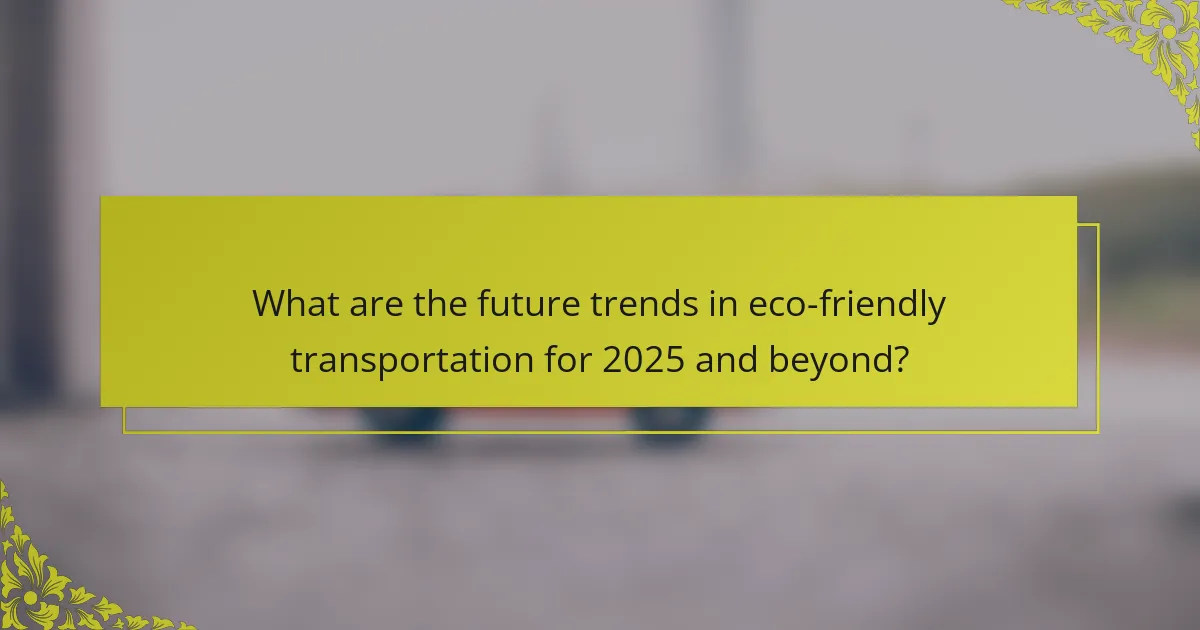
What are the future trends in eco-friendly transportation for 2025 and beyond?
Future trends in eco-friendly transportation will focus on electric vehicles, autonomous technology, and sustainable public transit solutions. Innovations will enhance energy efficiency and reduce carbon emissions.
Electric vehicles (EVs) will dominate the market, with advancements in battery technology leading to longer ranges and faster charging times. By 2025, many manufacturers aim for significant increases in EV production, supported by expanding charging infrastructure.
Autonomous vehicles will integrate with eco-friendly systems, optimizing traffic flow and lowering energy consumption. These smart vehicles will use real-time data to minimize emissions and enhance safety.
Sustainable public transit will gain traction, with cities investing in electric buses and rail systems. Moreover, bike-sharing and pedestrian-friendly initiatives will promote greener urban mobility options. These trends collectively aim to create a more sustainable transportation ecosystem.
How is the rise of remote work impacting transportation choices?
The rise of remote work is increasing the adoption of eco-friendly transportation options. Many individuals are choosing bicycles, electric scooters, and public transit over traditional cars. This shift reduces carbon footprints and alleviates traffic congestion. Additionally, companies are promoting sustainable commuting benefits, enhancing employee satisfaction and environmental responsibility.
What predictions can be made about the growth of electric vehicle markets?
The electric vehicle market is predicted to experience significant growth over the next decade. Factors driving this expansion include advancements in battery technology, increasing government incentives, and heightened consumer awareness of environmental issues. By 2030, the global electric vehicle market is expected to reach approximately 30% of total vehicle sales, up from around 10% in 2023. This shift will be fueled by the growing demand for sustainable transportation options and the declining costs of electric vehicle production. Additionally, the expansion of charging infrastructure will enhance accessibility and convenience for consumers, further accelerating market growth.
What best practices can individuals follow to maximize eco-friendly transportation benefits?
To maximize eco-friendly transportation benefits, individuals should prioritize sustainable options and practices. Choosing public transit, cycling, or walking reduces carbon footprints. Carpooling and using electric vehicles further enhance environmental benefits. Regular vehicle maintenance ensures optimal efficiency. Lastly, supporting local policies that promote eco-friendly infrastructure is crucial for long-term impact.
